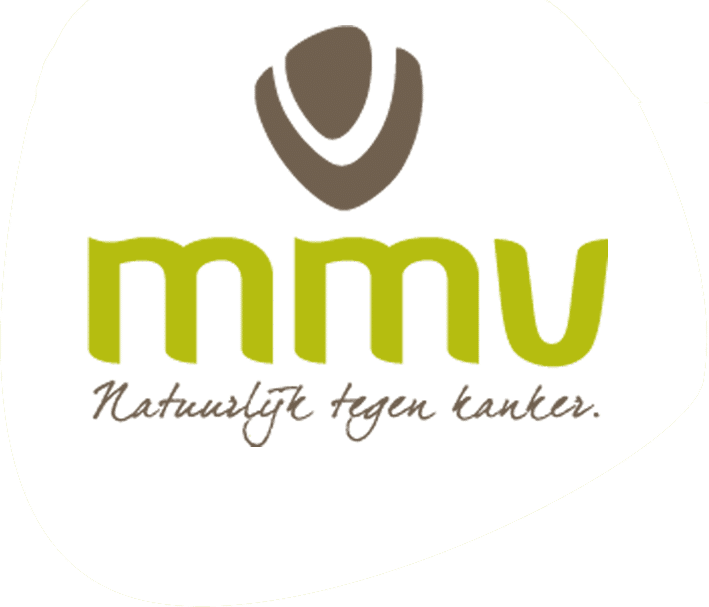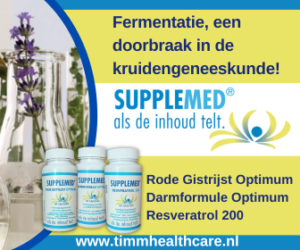Een tekort aan vitamine D hangt samen met het ontstaan van kanker, terwijl een hoge D-status is gerelateerd aan een langere overleving na de diagnose kanker. Naast een adequate vitamine D-status is een actieve vitamine D-receptor een belangrijk onderdeel in een anti-kankerstrategie.

Door Frits AJ Muskiet
Vitamine D is goed voor de botten. Het verhoogt de calcium- en fosfaatopname uit de darm en draagt daarmee bij aan de mineralisatie van ons skelet. Eigenlijk is vitamine D geen vitamine, want we kunnen het zelf maken onder invloed van zonlicht in onze huid. Vitamine D wordt in twee stappen omgezet in een actief hormoon (1-4). Het oefent zijn werking vooral uit via de vitamine D-receptor. Deze wordt in nagenoeg alle weefsels aangetroffen en heeft functies in het botmetabolisme, het immuunsysteem, bij de groei en ontwikkeling van weefsels, en nog veel meer (5). Het is dan ook niet verwonderlijk dat vitamine D betrokken is bij veel meer ziektes dan alleen rachitis (een stoornis van de botvorming bij kinderen), osteomalacie (botontkalking) en osteoporose (verlies van bot) (6,7).
Verstoorde D-functie
Bacteriën en virussen verstoren graag de vitamine D-functie om de werking van het immuunsysteem te saboteren en zichzelf sneller te kunnen vermenigvuldigen. Voorbeelden zijn virussen zoals Epstein-Barr (veroorzaakt o.a. Pfeiffer) en HIV (AIDS), bacteriën zoals ‘Mycobacterium leprae’ (lepra) en ‘Mycobacterium tuberculosis’ (tuberculose), en de schimmel Aspergillus fumigatus (o.a. longontsteking, allergie) (8,9). Ook kanker gedijt bij een verstoorde vitamine D-functie. Tumorcellen worden agressiever als ze hun vitamine D-receptor verliezen, de aanmaak van het vitamine D-hormoon verminderen of de afbraak ervan verhogen (10,11). Een actieve vitamine D-receptor wordt dan ook beschouwd als een ‘tumor suppressor’, een eiwit dat het ontstaan van kanker onderdrukt.
Vitamine D en kanker
De belangstelling voor de relatie tussen vitamine D en kanker groeit (12-14). In de Verenigde Staten is de hoeveelheid zonlicht gerelateerd aan dikkedarmkanker en borstkanker: van Noord naar Zuid nemen de incidentie en de sterfte als gevolg van deze tumoren af (15-18).
Een lage vitamine D-status is geassocieerd met het ontstaan van kanker van de dikke darm, borst, prostaat en pancreas (19-23), terwijl een hoge vitamine D-status is geassocieerd met een langere overleving van kankerpatiënten (19,24-30).
Maar of hier sprake is van oorzaak en gevolg? Dat is vooralsnog de vraag. Een grote studie uit 2018 met 25.871 deelnemers (gemiddelde leeftijd 67,1 jaar) waarbij gedurende 5,3 jaar per dag 2.000 IU (50 mcg) vitamine D of placebo werd gegeven, toonde geen verschil in het ontstaan van kanker (31). Wel was er een klein gunstig effect (1,7 procent versus 2,1 procent) op uitzaaiing en sterfte door kanker. Maar alleen bij diegenen met een normale BMI (<25 kg/m2) (32). De huidige gedachte is dat vitamine D kanker niet voorkomt maar wel de sterfte hieraan vermindert (33).
Melanoom
Belangrijk is daarbij de rol van de vitamine D-receptor (VDR; 34,35). In ons lichaam bevinden zich talrijke receptoren. Dit zijn eiwitten die signalen – van binnen of buiten de cel – doorgeven en zo reacties in het lichaam op gang brengen.
Recent liet een Zwitserse onderzoeksgroep onder leiding van Ewa Podgorska (36) zien dat het melanoom agressiever wordt als ze de VDR verwijderden. Buiten het lichaam groeiden deze ‘VDR-loze’ melanoomcellen niet alleen harder, ze vormden ook kolonies en verplaatsten zich sneller. Dit zijn kenmerken van een toegenomen kwaadaardigheid (36).
Ook keken de onderzoekers naar de invloed van het vitamine D-hormoon en van de ‘omzettingsproducten’ (metabolieten) die via een ‘alternatieve route’ uit vitamine D worden gemaakt. Een aantal van deze stoffen bleek, net als het vitamine D-hormoon, in staat om de kwaadaardigheid (13,37-41) van de melanoomcellen te onderdrukken. Wat echter opviel was dat ze dat ook deden in de melanoomcellen zonder vitamine D-receptor, alhoewel veel minder fanatiek. Dat moet dus wel via andere receptoren gebeuren. Deze ontdekking biedt perspectief om tumoren die – vanwege het verlies van hun VDR – meer kwaadaardig zijn geworden tot de orde te roepen.
Receptoren
Dat kan echter alleen met die metabolieten uit de alternatieve route, omdat deze in hoge dosis geen stijging van het calcium in het bloed(36,42) veroorzaken. Het vitamine D-hormoon doet dit wel en dat kan levensbedreigend zijn.
De ‘alternatieve’ vitamine D-metabolieten (13,41-47) zijn betrokken bij ziektes zoals kanker, auto-immuunziektes en het metabool syndroom (13). In een diermodel zijn gunstige effecten gemeten op reumatoïde artritis (48). Ook activeren ze een receptor (41,49-54) die betrokken is bij het onschadelijk maken van kanker-veroorzakende stoffen, zoals dioxine (55). Bovendien is deze aryl hydrocarbon receptor’ (AhR) ook nodig bij de groei, uitrijping en verplaatsing van cellen (55). Opvallend is dat de AhR in veel tumoren, waaronder melanomen (60), in grotere hoeveelheden aanwezig is en tumorgroei kan onderdrukken, maar ook bevorderen (55). Het verschil zit waarschijnlijk in de duur van de activering (52,55,58). Recent is aangetoond dat de AhR betrokken is bij het ontstaan van neurale buisdefecten (61).
De natuur zit complex en subtiel in elkaar. In 1953 constateerde Nobelprijswinnaar Peter Brian Medawar (62) – vrij vertaald – dat onze evolutie er niet een is van het gebruik van steeds weer nieuwe stoffen, maar van de uitbreiding van functies van stoffen die er vanaf het vroege begin al waren (63,64). Vitamine D is waarschijnlijk één van de eerste stoffen die door levensvormen werd benut. Om zich te beschermen tegen de ultraviolette straling van de zon en om de intensiteit daarvan te meten (65). De bevindingen van Podgorska en medewerkers (36) onderstrepen wat Darwin (1809-1882; ref 66) en Medawar (1915-1987; ref 63) destijds al feilloos begrepen. In een melancholieke bui verlang je naar hun tijd, toen Evidence Based Medicine nog niet bestond.
1. Holick MF. Vitamin D: importance in the prevention of cancers, type 1 diabetes, heart disease, and osteoporosis. Am J Clin Nutr. 2004 Mar;79(3):362-71. doi: 10.1093/ajcn/79.3.362. Erratum in: Am J Clin Nutr. 2004 May;79(5):890. PMID: 14985208.
https://pubmed.ncbi.nlm.nih.gov/14985208/
2. Holick MF. Sunlight and vitamin D for bone health and prevention of autoimmune diseases, cancers, and cardiovascular disease. Am J Clin Nutr. 2004 Dec;80(6 Suppl):1678S-88S. doi: 10.1093/ajcn/80.6.1678S. PMID: 15585788.
https://pubmed.ncbi.nlm.nih.gov/15585788/
3. Holick MF. Vitamin D: a d-lightful solution for health. J Investig Med. 2011 Aug;59(6):872-80. doi: 10.2310/JIM.0b013e318214ea2d. PMID: 21415774; PMCID: PMC3738435.
https://pubmed.ncbi.nlm.nih.gov/21415774/
4. Holick MF. Biological Effects of Sunlight, Ultraviolet Radiation, Visible Light, Infrared Radiation and Vitamin D for Health. Anticancer Res. 2016 Mar;36(3):1345-56. PMID: 26977036.
https://pubmed.ncbi.nlm.nih.gov/26977036/
5. Hossein-nezhad A, Spira A, Holick MF. Influence of vitamin D status and vitamin D3 supplementation on genome wide expression of white blood cells: a randomized double-blind clinical trial. PLoS One. 2013;8(3):e58725. doi: 10.1371/journal.pone.0058725. Epub 2013 Mar 20. PMID: 23527013; PMCID: PMC3604145.
https://pubmed.ncbi.nlm.nih.gov/23527013/
6. Charoenngam N, Shirvani A, Holick MF. Vitamin D for skeletal and non-skeletal health: What we should know. J Clin Orthop Trauma. 2019 Nov-Dec;10(6):1082-1093. doi: 10.1016/j.jcot.2019.07.004. Epub 2019 Jul 13. PMID: 31708633; PMCID: PMC6834997.
https://pubmed.ncbi.nlm.nih.gov/31708633/
7. Charoenngam N, Holick MF. Immunologic Effects of Vitamin D on Human Health and Disease. Nutrients. 2020 Jul 15;12(7):2097. doi: 10.3390/nu12072097. PMID: 32679784; PMCID: PMC7400911.
https://pubmed.ncbi.nlm.nih.gov/32679784/
8. Kongsbak M, Levring TB, Geisler C, von Essen MR. The vitamin d receptor and T cell function. Front Immunol. 2013 Jun 18;4:148. doi: 10.3389/fimmu.2013.00148. PMID: 23785369; PMCID: PMC3684798.
https://pubmed.ncbi.nlm.nih.gov/23785369/
9. Mangin M, Sinha R, Fincher K. Inflammation and vitamin D: the infection connection. Inflamm Res. 2014 Oct;63(10):803-19. doi: 10.1007/s00011-014-0755-z. Epub 2014 Jul 22. PMID: 25048990; PMCID: PMC4160567.
https://pubmed.ncbi.nlm.nih.gov/25048990/
10. Fleet JC, DeSmet M, Johnson R, Li Y. Vitamin D and cancer: a review of molecular mechanisms. Biochem J. 2012 Jan 1;441(1):61-76. doi: 10.1042/BJ20110744. PMID: 22168439; PMCID: PMC4572477.
https://pubmed.ncbi.nlm.nih.gov/22168439/
11. Zhang Q, Kanterewicz B, Buch S, Petkovich M, Parise R, Beumer J, Lin Y, Diergaarde B, Hershberger PA. CYP24 inhibition preserves 1α,25-dihydroxyvitamin D(3) anti-proliferative signaling in lung cancer cells. Mol Cell Endocrinol. 2012 May 15;355(1):153-61. doi: 10.1016/j.mce.2012.02.006. Epub 2012 Feb 22. PMID: 22386975; PMCID: PMC3312998.
https://pubmed.ncbi.nlm.nih.gov/22386975/
12. Gröschel C, Tennakoon S, Kállay E. Cytochrome P450 Vitamin D Hydroxylases in Inflammation and Cancer. Adv Pharmacol. 2015;74:413-58. doi: 10.1016/bs.apha.2015.03.002. Epub 2015 May 11. PMID: 26233913.
https://pubmed.ncbi.nlm.nih.gov/26233913/
13. Jeon SM, Shin EA. Exploring vitamin D metabolism and function in cancer. Exp Mol Med. 2018 Apr 16;50(4):1-14. doi: 10.1038/s12276-018-0038-9. PMID: 29657326; PMCID: PMC5938036.
https://pubmed.ncbi.nlm.nih.gov/29657326/
14. Grant WB. Review of Recent Advances in Understanding the Role of Vitamin D in Reducing Cancer Risk: Breast, Colorectal, Prostate, and Overall Cancer. Anticancer Res. 2020 Jan;40(1):491-499. doi: 10.21873/anticanres.13977. PMID: 31892604.
https://pubmed.ncbi.nlm.nih.gov/31892604/
15. Garland CF, Garland FC, Gorham ED, Lipkin M, Newmark H, Mohr SB, Holick MF. The role of vitamin D in cancer prevention. Am J Public Health. 2006 Feb;96(2):252-61. doi: 10.2105/AJPH.2004.045260. Epub 2005 Dec 27. PMID: 16380576; PMCID: PMC1470481.
https://pubmed.ncbi.nlm.nih.gov/16380576/
16. Garland CF, Garland FC. Do sunlight and vitamin D reduce the likelihood of colon cancer? Int J Epidemiol. 2006 Apr;35(2):217-20. doi: 10.1093/ije/dyi229. Epub 2005 Nov 22. PMID: 16303809.
https://pubmed.ncbi.nlm.nih.gov/16303809/
17. Grant WB. The role of geographical ecological studies in identifying diseases linked to UVB exposure and/or vitamin D. Dermatoendocrinol. 2016 Jan 8;8(1):e1137400. doi: 10.1080/19381980.2015.1137400. PMID: 27195055; PMCID: PMC4862381.
https://pubmed.ncbi.nlm.nih.gov/27195055/
18. Moukayed M, Grant WB. The roles of UVB and vitamin D in reducing risk of cancer incidence and mortality: A review of the epidemiology, clinical trials, and mechanisms. Rev Endocr Metab Disord. 2017 Jun;18(2):167-182. doi: 10.1007/s11154-017-9415-2. PMID: 28213657.
https://pubmed.ncbi.nlm.nih.gov/28213657/
19. Stubbins RE, Hakeem A, Núñez NP. Using components of the vitamin D pathway to prevent and treat colon cancer. Nutr Rev. 2012 Dec;70(12):721-9. doi: 10.1111/j.1753-4887.2012.00522.x. Epub 2012 Oct 12. PMID: 23206285; PMCID: PMC3514827.
https://pubmed.ncbi.nlm.nih.gov/23206285/
20. Jacobs ET, Kohler LN, Kunihiro AG, Jurutka PW. Vitamin D and Colorectal, Breast, and Prostate Cancers: A Review of the Epidemiological Evidence. J Cancer. 2016 Jan 5;7(3):232-40. doi: 10.7150/jca.13403. PMID: 26918035; PMCID: PMC4747876.
https://pubmed.ncbi.nlm.nih.gov/26918035/
21. Ekmekcioglu C, Haluza D, Kundi M. 25-Hydroxyvitamin D Status and Risk for Colorectal Cancer and Type 2 Diabetes Mellitus: A Systematic Review and Meta-Analysis of Epidemiological Studies. Int J Environ Res Public Health. 2017 Jan 28;14(2):127. doi: 10.3390/ijerph14020127. PMID: 28134804; PMCID: PMC5334681.
https://pubmed.ncbi.nlm.nih.gov/28134804/
22. Song D, Deng Y, Liu K, Zhou L, Li N, Zheng Y, Hao Q, Yang S, Wu Y, Zhai Z, Li H, Dai Z. Vitamin D intake, blood vitamin D levels, and the risk of breast cancer: a dose-response meta-analysis of observational studies. Aging (Albany NY). 2019 Dec 28;11(24):12708-12732. doi: 10.18632/aging.102597. Epub 2019 Dec 28. PMID: 31884419; PMCID: PMC6949087.
https://pubmed.ncbi.nlm.nih.gov/31884419/
23. Ferrer-Mayorga G, Larriba MJ, Crespo P, Muñoz A. Mechanisms of action of vitamin D in colon cancer. J Steroid Biochem Mol Biol. 2019 Jan;185:1-6. doi: 10.1016/j.jsbmb.2018.07.002. Epub 2018 Jul 4. PMID: 29981368.
https://pubmed.ncbi.nlm.nih.gov/29981368/
24. Porojnicu A, Robsahm TE, Berg JP, Moan J. Season of diagnosis is a predictor of cancer survival. Sun-induced vitamin D may be involved: a possible role of sun-induced Vitamin D. J Steroid Biochem Mol Biol. 2007 Mar;103(3-5):675-8. doi: 10.1016/j.jsbmb.2006.12.031. Epub 2007 Jan 16. PMID: 17229569.
https://pubmed.ncbi.nlm.nih.gov/17229569/
25. Tretli S, Schwartz GG, Torjesen PA, Robsahm TE. Serum levels of 25-hydroxyvitamin D and survival in Norwegian patients with cancer of breast, colon, lung, and lymphoma: a population-based study. Cancer Causes Control. 2012 Feb;23(2):363-70. doi: 10.1007/s10552-011-9885-6. Epub 2011 Dec 23. PMID: 22193397; PMCID: PMC3261400.
https://pubmed.ncbi.nlm.nih.gov/22193397/
26. Keum N, Giovannucci E. Vitamin D supplements and cancer incidence and mortality: a meta-analysis. Br J Cancer. 2014 Aug 26;111(5):976-80. doi: 10.1038/bjc.2014.294. Epub 2014 Jun 10. PMID: 24918818; PMCID: PMC4150260.
https://pubmed.ncbi.nlm.nih.gov/24918818/
27. Mohr SB, Gorham ED, Kim J, Hofflich H, Cuomo RE, Garland CF. Could vitamin D sufficiency improve the survival of colorectal cancer patients? J Steroid Biochem Mol Biol. 2015 Apr;148:239-44. doi: 10.1016/j.jsbmb.2014.12.010. Epub 2014 Dec 19. PMID: 25533386.
https://pubmed.ncbi.nlm.nih.gov/25533386/
28. Ou B, Zhao J, Guan S, Lu A. Plasma 25-hydroxyvitamin D levels and survival of colorectal cancer patients: a meta-analysis. Eur J Cancer. 2015 Apr;51(6):786-8. doi: 10.1016/j.ejca.2015.01.010. Epub 2015 Mar 4. PMID: 25746389.
https://pubmed.ncbi.nlm.nih.gov/25746389/
29. Lappe J, Garland C, Gorham E. Vitamin D Supplementation and Cancer Risk. JAMA. 2017 Jul 18;318(3):299-300. doi: 10.1001/jama.2017.7857. PMID: 28719689.
https://pubmed.ncbi.nlm.nih.gov/28719689/
30. Li C, Li H, Zhong H, Li X. Association of 25-hydroxyvitamin D level with survival outcomes in female breast cancer patients: A meta-analysis. J Steroid Biochem Mol Biol. 2021 Jun 30;212:105947. doi: 10.1016/j.jsbmb.2021.105947. Epub ahead of print. PMID: 34214604.
https://pubmed.ncbi.nlm.nih.gov/34214604/
31. Manson JE, Cook NR, Lee IM, Christen W, Bassuk SS, Mora S, Gibson H, Gordon D, Copeland T, D’Agostino D, Friedenberg G, Ridge C, Bubes V, Giovannucci EL, Willett WC, Buring JE; VITAL Research Group. Vitamin D Supplements and Prevention of Cancer and Cardiovascular Disease. N Engl J Med. 2019 Jan 3;380(1):33-44. doi: 10.1056/NEJMoa1809944. Epub 2018 Nov 10. PMID: 30415629; PMCID: PMC6425757.
https://pubmed.ncbi.nlm.nih.gov/30415629/
32. Chandler PD, Chen WY, Ajala ON, Hazra A, Cook N, Bubes V, Lee IM, Giovannucci EL, Willett W, Buring JE, Manson JE; VITAL Research Group. Effect of Vitamin D3 Supplements on Development of Advanced Cancer: A Secondary Analysis of the VITAL Randomized Clinical Trial. JAMA Netw Open. 2020 Nov 2;3(11):e2025850. doi: 10.1001/jamanetworkopen.2020.25850. Erratum in: JAMA Netw Open. 2020 Dec 1;3(12):e2032460. PMID: 33206192; PMCID: PMC7675103.
https://pubmed.ncbi.nlm.nih.gov/33206192/
33. Keum N, Lee DH, Greenwood DC, Manson JE, Giovannucci E. Vitamin D supplementation and total cancer incidence and mortality: a meta-analysis of randomized controlled trials. Ann Oncol. 2019 May 1;30(5):733-743. doi: 10.1093/annonc/mdz059. PMID: 30796437; PMCID: PMC6821324.
https://pubmed.ncbi.nlm.nih.gov/30796437/
34. Mutchie TR, Yu OB, Di Milo ES, Arnold LA. Alternative binding sites at the vitamin D receptor and their ligands. Mol Cell Endocrinol. 2019 Apr 5;485:1-8. doi: 10.1016/j.mce.2019.01.011. Epub 2019 Jan 14. PMID: 30654005; PMCID: PMC6444937.
https://pubmed.ncbi.nlm.nih.gov/30654005/
35. Warwick T, Schulz MH, Günther S, Gilsbach R, Neme A, Carlberg C, Brandes RP, Seuter S. A hierarchical regulatory network analysis of the vitamin D induced transcriptome reveals novel regulators and complete VDR dependency in monocytes. Sci Rep. 2021 Mar 22;11(1):6518. doi: 10.1038/s41598-021-86032-5. PMID: 33753848; PMCID: PMC7985518.
https://pubmed.ncbi.nlm.nih.gov/33753848/
36. Podgorska E, Kim TK, Janjetovic Z, Urbanska K, Tuckey RC, Bae S, Slominski AT. Knocking out the Vitamin D Receptor Enhances Malignancy and Decreases Responsiveness to Vitamin D3 Hydroxyderivatives in Human Melanoma Cells. Cancers (Basel). 2021 Jun 22;13(13):3111. doi: 10.3390/cancers13133111. PMID: 34206371; PMCID: PMC8269360.
https://pubmed.ncbi.nlm.nih.gov/34206371/
37. Slominski AT, Kim TK, Li W, Yi AK, Postlethwaite A, Tuckey RC. The role of CYP11A1 in the production of vitamin D metabolites and their role in the regulation of epidermal functions. J Steroid Biochem Mol Biol. 2014 Oct;144 Pt A:28-39. doi: 10.1016/j.jsbmb.2013.10.012. Epub 2013 Oct 28. PMID: 24176765; PMCID: PMC4002668.
https://pubmed.ncbi.nlm.nih.gov/24176765/
38. Slominski AT, Li W, Kim TK, Semak I, Wang J, Zjawiony JK, Tuckey RC. Novel activities of CYP11A1 and their potential physiological significance. J Steroid Biochem Mol Biol. 2015 Jul;151:25-37. doi: 10.1016/j.jsbmb.2014.11.010. Epub 2014 Nov 13. PMID: 25448732; PMCID: PMC4757911.
https://pubmed.ncbi.nlm.nih.gov/25448732/
39. Slominski AT, Brożyna AA, Zmijewski MA, Jóźwicki W, Jetten AM, Mason RS, Tuckey RC, Elmets CA. Vitamin D signaling and melanoma: role of vitamin D and its receptors in melanoma progression and management. Lab Invest. 2017 Jun;97(6):706-724. doi: 10.1038/labinvest.2017.3. Epub 2017 Feb 20. PMID: 28218743; PMCID: PMC5446295.
https://pubmed.ncbi.nlm.nih.gov/28218743/
40. Slominski AT, Kim TK, Janjetovic Z, Brożyna AA, Żmijewski MA, Xu H, Sutter TR, Tuckey RC, Jetten AM, Crossman DK. Differential and Overlapping Effects of 20,23(OH)₂D3 and 1,25(OH)₂D3 on Gene Expression in Human Epidermal Keratinocytes: Identification of AhR as an Alternative Receptor for 20,23(OH)₂D3. Int J Mol Sci. 2018 Oct 8;19(10):3072. doi: 10.3390/ijms19103072. PMID: 30297679; PMCID: PMC6213311.
https://pubmed.ncbi.nlm.nih.gov/30297679/
41. Slominski AT, Chaiprasongsuk A, Janjetovic Z, Kim TK, Stefan J, Slominski RM, Hanumanthu VS, Raman C, Qayyum S, Song Y, Song Y, Panich U, Crossman DK, Athar M, Holick MF, Jetten AM, Zmijewski MA, Zmijewski J, Tuckey RC. Photoprotective Properties of Vitamin D and Lumisterol Hydroxyderivatives. Cell Biochem Biophys. 2020 Jun;78(2):165-180. doi: 10.1007/s12013-020-00913-6. Epub 2020 May 22. PMID: 32441029; PMCID: PMC7347247.
https://pubmed.ncbi.nlm.nih.gov/32441029/
42. Wang J, Slominski A, Tuckey RC, Janjetovic Z, Kulkarni A, Chen J, Postlethwaite AE, Miller D, Li W. 20-hydroxyvitamin D₃ inhibits proliferation of cancer cells with high efficacy while being non-toxic. Anticancer Res. 2012 Mar;32(3):739-46. PMID: 22399586; PMCID: PMC3312810.
https://pubmed.ncbi.nlm.nih.gov/22399586/
43. Boukhtouche F, Mariani J, Tedgui A. The “CholesteROR” protective pathway in the vascular system. Arterioscler Thromb Vasc Biol. 2004 Apr;24(4):637-43. doi: 10.1161/01.ATV.0000119355.56036.de. Epub 2004 Jan 29. PMID: 14751813.
https://pubmed.ncbi.nlm.nih.gov/14751813/
44. Slominski AT, Kim TK, Hobrath JV, Janjetovic Z, Oak ASW, Postlethwaite A, Lin Z, Li W, Takeda Y, Jetten AM, Tuckey RC. Characterization of a new pathway that activates lumisterol in vivo to biologically active hydroxylumisterols. Sci Rep. 2017 Sep 12;7(1):11434. doi: 10.1038/s41598-017-10202-7. PMID: 28900196; PMCID: PMC5595834.
https://pubmed.ncbi.nlm.nih.gov/28900196/
45. Jetten AM, Takeda Y, Slominski A, Kang HS. Retinoic acid-related Orphan Receptor γ (RORγ): connecting sterol metabolism to regulation of the immune system and autoimmune disease. Curr Opin Toxicol. 2018 Apr;8:66-80. doi: 10.1016/j.cotox.2018.01.005. Epub 2018 Feb 1. PMID: 29568812; PMCID: PMC5858703.
https://pubmed.ncbi.nlm.nih.gov/29568812/
46. Imai Y, Youn MY, Inoue K, Takada I, Kouzmenko A, Kato S. Nuclear receptors in bone physiology and diseases. Physiol Rev. 2013 Apr;93(2):481-523. doi: 10.1152/physrev.00008.2012. PMID: 23589826; PMCID: PMC3768103.
https://pubmed.ncbi.nlm.nih.gov/23589826/
47. Fan J, Lv Z, Yang G, Liao TT, Xu J, Wu F, Huang Q, Guo M, Hu G, Zhou M, Duan L, Liu S, Jin Y. Retinoic Acid Receptor-Related Orphan Receptors: Critical Roles in Tumorigenesis. Front Immunol. 2018 May 31;9:1187. doi: 10.3389/fimmu.2018.01187. PMID: 29904382; PMCID: PMC5990620.
https://pubmed.ncbi.nlm.nih.gov/29904382/
48. Postlethwaite AE, Tuckey RC, Kim TK, Li W, Bhattacharya SK, Myers LK, Brand DD, Slominski AT. 20S-Hydroxyvitamin D3, a Secosteroid Produced in Humans, Is Anti-Inflammatory and Inhibits Murine Autoimmune Arthritis. Front Immunol. 2021 Jun 30;12:678487. doi: 10.3389/fimmu.2021.678487. PMID: 34276665; PMCID: PMC8278399.
https://pubmed.ncbi.nlm.nih.gov/34276665/
49. Dupont E, Gomez J, Bilodeau D. Beyond UV radiation: a skin under challenge. Int J Cosmet Sci. 2013 Jun;35(3):224-32. doi: 10.1111/ics.12036. Epub 2013 Feb 14. PMID: 23406155.
https://pubmed.ncbi.nlm.nih.gov/23406155/
50. Di Giulio RT, Clark BW. The Elizabeth River Story: A Case Study in Evolutionary Toxicology. J Toxicol Environ Health B Crit Rev. 2015;18(6):259-98. doi: 10.1080/15320383.2015.1074841. Epub 2015 Oct 27. PMID: 26505693; PMCID: PMC4733656.
https://pubmed.ncbi.nlm.nih.gov/26505693/
51. Memari B, Nguyen-Yamamoto L, Salehi-Tabar R, Zago M, Fritz JH, Baglole CJ, Goltzman D, White JH. Endocrine aryl hydrocarbon receptor signaling is induced by moderate cutaneous exposure to ultraviolet light. Sci Rep. 2019 Jun 11;9(1):8486. doi: 10.1038/s41598-019-44862-4. PMID: 31186463; PMCID: PMC6560103.
https://pubmed.ncbi.nlm.nih.gov/31186463/
52. Vogeley C, Esser C, Tüting T, Krutmann J, Haarmann-Stemmann T. Role of the Aryl Hydrocarbon Receptor in Environmentally Induced Skin Aging and Skin Carcinogenesis. Int J Mol Sci. 2019 Nov 28;20(23):6005. doi: 10.3390/ijms20236005. PMID: 31795255; PMCID: PMC6928879.
https://pubmed.ncbi.nlm.nih.gov/31795255/
53. Rothhammer V, Quintana FJ. The aryl hydrocarbon receptor: an environmental sensor integrating immune responses in health and disease. Nat Rev Immunol. 2019 Mar;19(3):184-197. doi: 10.1038/s41577-019-0125-8. PMID: 30718831.
https://pubmed.ncbi.nlm.nih.gov/30718831/
54. Barroso A, Mahler JV, Fonseca-Castro PH, Quintana FJ. The aryl hydrocarbon receptor and the gut-brain axis. Cell Mol Immunol. 2021 Feb;18(2):259-268. doi: 10.1038/s41423-020-00585-5. Epub 2021 Jan 6. PMID: 33408340; PMCID: PMC8027889.
https://pubmed.ncbi.nlm.nih.gov/33408340/
55. Perepechaeva ML, Grishanova AY. The Role of Aryl Hydrocarbon Receptor (AhR) in Brain Tumors. Int J Mol Sci. 2020 Apr 20;21(8):2863. doi: 10.3390/ijms21082863. PMID: 32325928; PMCID: PMC7215596.
https://pubmed.ncbi.nlm.nih.gov/32325928/
56. Syed DN, Mukhtar H. FICZ: A Messenger of Light in Human Skin. J Invest Dermatol. 2015 Jun;135(6):1478-1481. doi: 10.1038/jid.2015.52. PMID: 25964268.
https://pubmed.ncbi.nlm.nih.gov/25964268/
57. Smirnova A, Wincent E, Vikström Bergander L, Alsberg T, Bergman J, Rannug A, Rannug U. Evidence for New Light-Independent Pathways for Generation of the Endogenous Aryl Hydrocarbon Receptor Agonist FICZ. Chem Res Toxicol. 2016 Jan 19;29(1):75-86. doi: 10.1021/acs.chemrestox.5b00416. Epub 2015 Dec 30. PMID: 26686552.
https://pubmed.ncbi.nlm.nih.gov/26686552/
58. Rannug A, Rannug U. The tryptophan derivative 6-formylindolo[3,2-b]carbazole, FICZ, a dynamic mediator of endogenous aryl hydrocarbon receptor signaling, balances cell growth and differentiation. Crit Rev Toxicol. 2018 Aug;48(7):555-574. doi: 10.1080/10408444.2018.1493086. Epub 2018 Sep 18. PMID: 30226107.
https://pubmed.ncbi.nlm.nih.gov/30226107/
59. Zhang C, Creech KL, Zuercher WJ, Willson TM. Gram-scale synthesis of FICZ, a photoreactive endogenous ligand of the aryl hydrocarbon receptor. Sci Rep. 2019 Jul 10;9(1):9982. doi: 10.1038/s41598-019-46374-7. PMID: 31292477; PMCID: PMC6620467.
https://pubmed.ncbi.nlm.nih.gov/31292477/
60. Paris A, Tardif N, Galibert MD, Corre S. AhR and Cancer: From Gene Profiling to Targeted Therapy. Int J Mol Sci. 2021 Jan 13;22(2):752. doi: 10.3390/ijms22020752. PMID: 33451095; PMCID: PMC7828536.
https://pubmed.ncbi.nlm.nih.gov/33451095/
61. Kim DJ, Venkataraman A, Jain PC, Wiesler EP, DeBlasio M, Klein J, Tu SS, Lee S, Medzhitov R, Iwasaki A. Vitamin B12 and folic acid alleviate symptoms of nutritional deficiency by antagonizing aryl hydrocarbon receptor. Proc Natl Acad Sci U S A. 2020 Jul 7;117(27):15837-15845. doi: 10.1073/pnas.2006949117. Epub 2020 Jun 22. PMID: 32571957; PMCID: PMC7355044.
https://pubmed.ncbi.nlm.nih.gov/32571957/
62. Peter Medawar (1915-1987). Wikipedia, accessed 4 August 2021.
https://nl.wikipedia.org/wiki/Peter_Medawar
63. Medawar PB. Some immunological and endocrinological problems raised by the evolution of viviparity in vertebrates. In Symposium of the Society of Experimental Biology, No. VII Evolution. Cambridge University Press (1953) pp. 320-338
https://www.scienceopen.com/document?vid=d66cb799-1041-4ed0-81c6-c3d639a78be5
64. Venter JC, di Porzio U, Robinson DA, Shreeve SM, Lai J, Kerlavage AR, Fracek SP Jr, Lentes KU, Fraser CM. Evolution of neurotransmitter receptor systems. Prog Neurobiol. 1988;30(2-3):105-69. doi: 10.1016/0301-0082(88)90004-4. PMID: 2830635.
https://pubmed.ncbi.nlm.nih.gov/2830635/
65. Holick MF. Vitamin D: A millenium perspective. J Cell Biochem. 2003 Feb 1;88(2):296-307. doi: 10.1002/jcb.10338. PMID: 12520530.
https://pubmed.ncbi.nlm.nih.gov/12520530/
66. Charles Darwin (1809-1882). Wikipedia, accessed 4 August 2021.
MMV maakt wekelijks een selectie uit het nieuws over voeding en leefstijl in relatie tot kanker en andere medische condities.
Inschrijven nieuwsbrief








